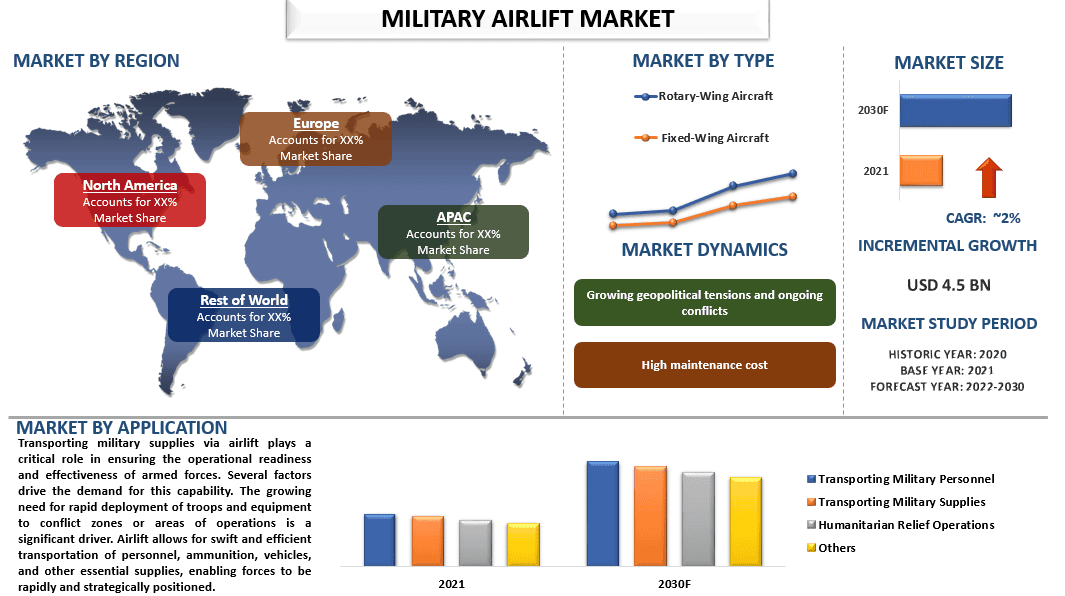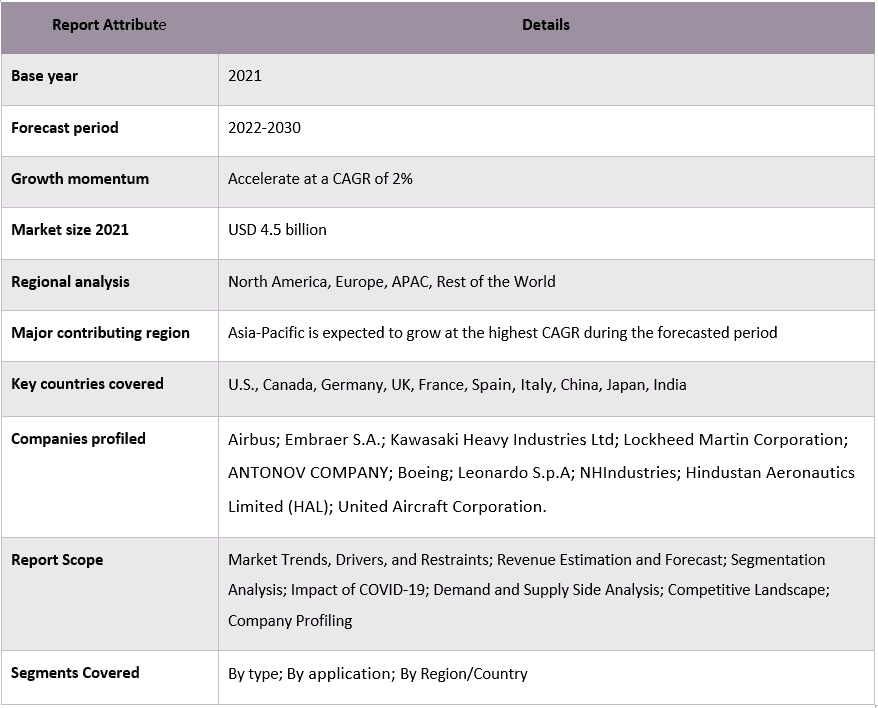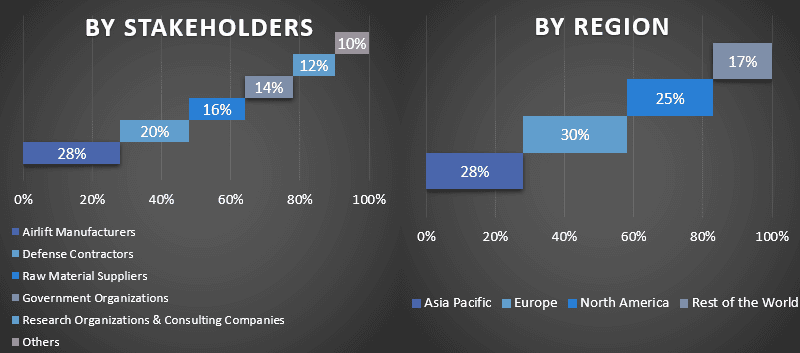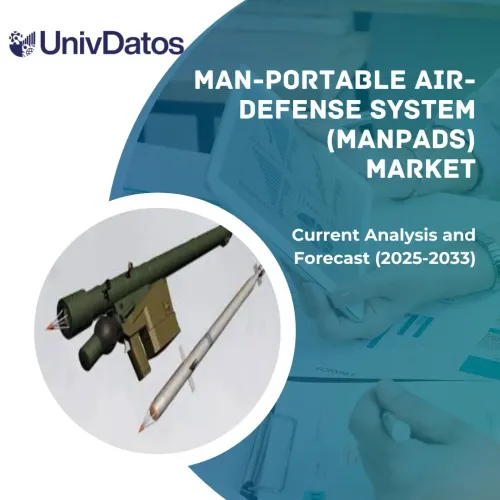- Home
- About Us
- Industry
- Services
- Reading
- Contact Us
Military Airlift Market: Current Analysis and Forecast (2022-2030)
Emphasis on Type (Rotary-Wing Aircraft, Autonomous Delivery Vehicle); Application (Transporting Military Personnel, Transporting Military Supplies, Humanitarian Relief Operations, and Others); and Region/Country

Military Airlift Market was valued at USD 4.5 Billion in 2021 & is expected to grow at a CAGR of 2% from 2022-2030 owing to the growing demand for advanced freight and arms transport systems. Military airlift refers to the transportation of personnel, equipment, vehicles, weapons, and medical and food supplies by air to remote locations. It involves the use of various aircraft, such as transport planes, cargo planes, and helicopters, which are designed and equipped to carry a large amount of cargo during challenging conditions like combat zones or adverse weather conditions. It generally runs for tactical purposes while relying on smaller and more agile aircraft that are more capable of landing or taking off from shorter and paved runways. It helps evacuate wounded or injured soldiers from combat zones to facilities. It also assists in enhancing force protection by minimizing exposure to ground threats.
Some of the major players operating in the market include Airbus; Embraer S.A.; Kawasaki Heavy Industries Ltd; Lockheed Martin Corporation; ANTONOV COMPANY; Boeing; Leonardo S.p.A; NHIndustries; Hindustan Aeronautics Limited (HAL); United Aircraft Corporation. Several M&As along with partnerships have been undertaken by these players to facilitate customers with hi-tech and innovative products/technologies.
Insights Presented in the Report
“Based on the application, the market has been categorized as transporting military personnel, transporting military supplies, humanitarian relief operations, and others. Among them, the diesel segment held a considerable share of the market in 2021.”
Based on the application, the market has been categorized as transporting military personnel, transporting military supplies, humanitarian relief operations, and others. Among them, the humanitarian relief operations segment held a considerable share of the market in 2021. The urgency and time sensitivity of humanitarian aid delivery make airlift a crucial option. Airlift allows for the rapid transportation of emergency relief supplies, including food, water, medical equipment, and temporary shelter, to affected areas. This timely response is essential for saving lives and providing immediate assistance to affected populations. In addition, the ability of airlift to overcome logistical challenges and access remote or disaster-stricken regions is a significant driver. Often, infrastructure and transportation networks are severely damaged or non-existent in such areas, making traditional ground transportation difficult or impossible. Airlift provides a reliable and efficient means of delivering aid directly to affected populations, bypassing road or sea transportation limitations. Additionally, the versatility of airlift allows for the evacuation of vulnerable populations, including the wounded, displaced civilians, or foreign nationals, from dangerous or inhospitable areas, ensuring their safety and well-being.
“Based on the type, the market has been categorized into rotary-wing aircraft and fixed-wing aircraft. Among them, the rotary-wing aircraft segment held a considerable share of the market in 2021.”
Based on the type, the market has been categorized into rotary-wing aircraft and fixed-wing aircraft. Among them, the rotary-wing aircraft segment held a considerable share of the market in 2021. Rotary-wing platforms offer unique advantages, such as vertical takeoff and landing capabilities, maneuverability in complex environments, and the ability to conduct close air support and medical evacuation operations. This has led to increased investments in rotary-wing airlift capabilities. For instance, the U.S. Army’s Future Vertical Lift (FVL) program, launched in 2011, aims to develop next-generation rotary-wing aircraft with improved speed, range, and performance. The FVL program represents a substantial investment in advancing rotary-wing airlift technology to meet evolving mission requirements. Additionally, countries invest in specialized rotary-wing platforms, such as combat search and rescue helicopters or heavy-lift helicopters, to enhance their military’s operational capabilities. The growth of rotary-wing airlift is also driven by the increasing need for rapid response and support in remote or rugged terrains, where helicopters excel in delivering troops, supplies, and providing close air support.
“Asia-Pacific holds the highest share of the military airlift market in 2021.”
The need for rapid response and deployment of forces in today’s dynamic security environment drives the demand for military airlift capabilities. Nations invest in advanced transport aircraft and infrastructure to enhance their strategic mobility and ability to project power and the rising demand for humanitarian assistance and disaster relief operations necessitates effective military airlift capabilities. Instances such as the delivery of relief supplies, medical assistance, and evacuation of affected populations in response to natural disasters or humanitarian crises underline the importance of robust airlift capabilities.
Military Airlift Market Report Coverage

Reasons to buy this report:
- The study includes market sizing and forecasting analysis validated by authenticated key industry experts.
- The report presents a quick review of overall industry performance at one glance.
- The report covers an in-depth analysis of prominent industry peers with a primary focus on key business financials, product portfolios, expansion strategies, and recent developments.
- Detailed examination of drivers, restraints, key trends, and opportunities prevailing in the industry.
- The study comprehensively covers the market across different segments.
- Deep dive regional level analysis of the industry.
Customization Options:
The global military airlift market can further be customized as per the requirement or any other market segment. Besides this, UMI understands that you may have your own business needs, hence feel free to contact us to get a report that completely suits your requirements.
Table of Content
Research Methodology for the Military Airlift Market Analysis (2022-2030)
Analyzing the historical market, estimating the current market, and forecasting the future market of the global military airlift market were the three major steps undertaken to create and analyze the adoption of military airlift in major regions globally. Exhaustive secondary research was conducted to collect the historical market numbers and estimate the current market size. Secondly, to validate these insights, numerous findings and assumptions were taken into consideration. Moreover, exhaustive primary interviews were also conducted, with industry experts across the value chain of the global military airlift market. Post assumption and validation of market numbers through primary interviews, we employed a top-down/bottom-up approach to forecasting the complete market size. Thereafter, market breakdown and data triangulation methods were adopted to estimate and analyze the market size of segments and sub-segments of the industry pertains to. Detailed methodology is explained below:
Analysis of Historical Market Size
Step 1: In-Depth Study of Secondary Sources:
Detail secondary study was conducted to obtain the historical market size of the military airlift market through company internal sources such as annual reports & financial statements, performance presentations, press releases, etc., and external sources including journals, news & articles, government publications, competitor publications, sector reports, third-party database, and other credible publications.
Step 2: Market Segmentation:
After obtaining the historical market size of the military airlift market, we conducted a detailed secondary analysis to gather historical market insights and share for different segments & sub-segments for major regions. Major segments are included in the report by type and application. Further country-level analyses were conducted to evaluate the overall adoption of testing models in that region.
Step 3: Factor Analysis:
After acquiring the historical market size of different segments and sub-segments, we conducted a detailed factor analysis to estimate the current market size of the military airlift market. Further, we conducted factor analysis using dependent and independent variables such as type and application of the military airlift market. A thorough analysis was conducted of demand and supply-side scenarios considering top partnerships, mergers and acquisitions, business expansion, and product launches in the military airlift market sector across the globe.
Current Market Size Estimate & Forecast
Current Market Sizing: Based on actionable insights from the above 3 steps, we arrived at the current market size, key players in the global military airlift market, and market shares of the segments. All the required percentage shares split, and market breakdowns were determined using the above-mentioned secondary approach and were verified through primary interviews.
Estimation & Forecasting: For market estimation and forecast, weights were assigned to different factors including drivers & trends, restraints, and opportunities available for the stakeholders. After analyzing these factors, relevant forecasting techniques i.e., the top-down/bottom-up approach were applied to arrive at the market forecast for 2028 for different segments and sub-segments across the major markets globally. The research methodology adopted to estimate the market size encompasses:
- The industry’s market size, in terms of revenue (USD) and the adoption rate of the military airlift market across the major markets domestically
- All percentage shares, splits, and breakdowns of market segments and sub-segments
- Key players in the global military airlift market in terms of products offered. Also, the growth strategies adopted by these players to compete in the fast-growing market
Market Size and Share Validation
Primary Research: In-depth interviews were conducted with the Key Opinion Leaders (KOLs) including Top Level Executives (CXO/VPs, Sales Head, Marketing Head, Operational Head, Regional Head, Country Head, etc.) across major regions. Primary research findings were then summarized, and statistical analysis was performed to prove the stated hypothesis. Inputs from primary research were consolidated with secondary findings, hence turning information into actionable insights.
Split of Primary Participants in Different Regions

Market Engineering
The data triangulation technique was employed to complete the overall market estimation and to arrive at precise statistical numbers for each segment and sub-segment of the global military airlift market. data was split into several segments & sub-segments post studying various parameters and trends in the areas of the type and application in the global military airlift market.
The main Objective of the Global Military Airlift Market Study
The current & future market trends of the global military airlift market were pinpointed in the study. Investors can gain strategic insights to base their discretion for investments on the qualitative and quantitative analysis performed in the study. Current and future market trends determined the overall attractiveness of the market at a regional level, providing a platform for the industrial participant to exploit the untapped market to benefit from a first-mover advantage. Other quantitative goals of the studies include:
- Analyze the current and forecast market size of the military airlift market in terms of value (USD). Also, analyze the current and forecast market size of different segments and sub-segments.
- Segments in the study include areas of the type and application.
- Define and analysis of the regulatory framework for the military airlift industry.
- Analyze the value chain involved with the presence of various intermediaries, along with analyzing customer and competitor behaviors of the industry.
- Analyze the current and forecast market size of the military airlift market for the major region.
- Major countries of regions studied in the report include Asia Pacific, Europe, North America, and the Rest of the World
- Company profiles of the military airlift market and the growth strategies adopted by the market players to sustain in the fast-growing market.
- Deep dive regional level analysis of the industry
Related Reports
Customers who bought this item also bought










